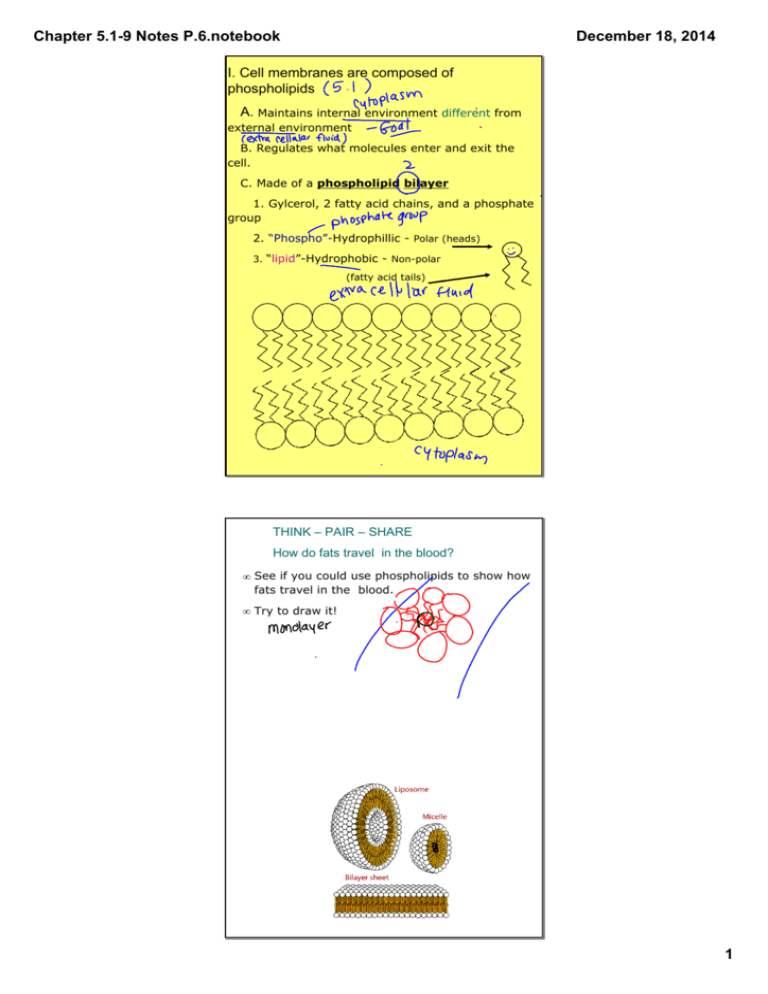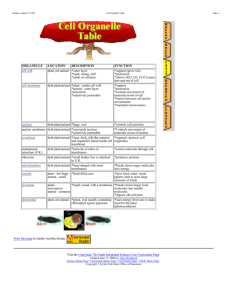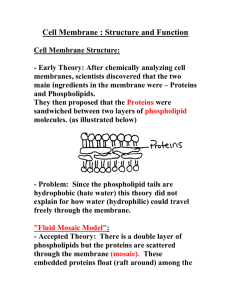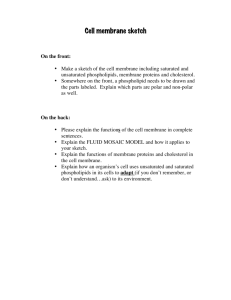Chapter 5.1-9 Notes P.6.notebook
advertisement

Chapter 5.1­9 Notes P.6.notebook December 18, 2014 I. Cell membranes are composed of phospholipids A. Maintains internal environment different from external environment B. Regulates what molecules enter and exit the cell. C. Made of a phospholipid bilayer 1. Gylcerol, 2 fatty acid chains, and a phosphate group 2. “Phospho”­Hydrophillic ­ Polar (heads) 3. “lipid”­Hydrophobic ­ Non­polar (fatty acid tails) THINK – PAIR – SHARE How do fats travel in the blood? • See if you could use phospholipids to show how fats travel in the blood. • Try to draw it! 1 Chapter 5.1­9 Notes P.6.notebook December 18, 2014 D. Fluid Mosaic Model 1. Mosaic: Diverse proteins embedded into the surface and interior of the membrane 2. Fluid: Unsaturated fatty acid tails, create kinks ­ prevent fatty acids from clumping together a. Cholesterol: b. Phospholipids can move: http://telstar.ote.cmu.edu/biology/MembranePage/index2.html E. Membrane Proteins 1. Integrins create a strong framework for the cell (attach to cytoskeleton inside cell) 2. Glycoproteins: carbohydrate chains attached to membrane proteins, carbohydrate ID tags help in cell­cell recognition 3. Transport Proteins: http://www.stolaf.edu/people/giannini/flashanimat/transport/channel.swf 4. Enzymes: carry out sequential steps in a reaction 5. Receptor Proteins: shape that fits a particular Animation messenger and triggers a response into the cell G. Lipids and Cell Membrane 1. Glycolipids: lipids in plasma membranes that bears a carbohydrate chain attached to a hydrophobic tail\ a. Used to provide energy to the cell b. Serve as markers for cellular recognition. 2. Cholesterol 3. Phospholipids 2 Chapter 5.1­9 Notes P.6.notebook December 18, 2014 DO NOW Label #1­5. What are three names for the structure below? HMWK: R/O 28.3 II. Membranes formed Spontaneously A. Phospholipids form membranes ‐ essential for early life B. Regulate internal and external environment is first step in formation of cells 3 Chapter 5.1­9 Notes P.6.notebook December 18, 2014 III. Diffusion ‐ Movement of molecules from High concentration to Low Concentration by random motion • Dynamic Equilibrium­ continues movement but no NET overall change Animation 1 Animation 2 A. Diffusion is controlled by: 1. Temperature 2. Pressure: 3. Size of Molecules: 4. Charge of Molecules: B. Passive Transport: Movement of particles across the cell membrane without using energy 1. Movement through phospholipids 2. Small and/or nonpolar molecules can cross (ex. O2, CO2) C. Osmosis: diffusion of water across the membrane 1. Water always flows via osmosis from HIGH water concentration to LOW water concentration through a semi permeable membrane. Animation Let's try some examples: ` 1. Indicate the direction of net water movement between two solutions: 2% sucrose and a 5% sucrose solutions. The membrane is not permeable to sucrose. 2. 4 Chapter 5.1­9 Notes P.6.notebook December 18, 2014 3. Tonicity: ability of a solution to lose or gain water a. isotonic: solute concentration is same inside and outside the cell (ex)­ b. hypertonic: area of higher solutes c. hypotonic: area of lower solutes animation Do Now Let's try some examples: 1. Indicate the direction of net water movement between two solutions: 2% sucrose and a 5% sucrose solutions. The membrane is not permeable to sucrose. 2.The cell membrane is not permeable to salt. a. What is going to move? b. Where? c. What will happen to the cell? 5 Chapter 5.1­9 Notes P.6.notebook December 18, 2014 4. Osmoregulation: regulation of uptake and loss of water a. Needed to keep animal cells alive b. Ex ‐ Freshwater fish live in hypotonic environment‐ kidneys and gills work to keep excess water out of fish Do Now • For the following examples: the membrane is not permeable to salt. > 1. Which way is the water moving > 2. What kind of cell solution (outside)? > 3. What is going to happen to the cells? 6 Chapter 5.1­9 Notes P.6.notebook December 18, 2014 7 Chapter 5.1­9 Notes P.6.notebook December 18, 2014 D. Facilitated Diffusion: use of transport proteins in diffusion of large and/or charged molecules (ex. sugars, amino acids, ions, and water) 1. Type of passive transport 2. Does not require energy 3. Molecules move from high to low concentration 4. Types of transport proteins: a. Channel Protein: hydrophilic tunnel protein b. Carrier Protein: changes shape to allow molecules through http://www.stolaf.edu/people/giannini/flashanimat/transport/channel.swf http://www.stolaf.edu/people/giannini/flashanimat/transport/caryprot.swf c. Aquaporins: protein used in rapid diffusion of water http://www.youtube.com/watch?v=7EGPtMqZ7pY E. Active Transport: movement of solutes against concentration gradient 1. Low to High solute concentration 2. Energy needed to go against concentration gradient (ATP ‐ type of N.A.) 3. Steps: a. Solute in cytoplasm attaches to a binding site on the protein b. ATP ‐ transfers one phosphate group to the protein c. Causes a change in shape so that the solute can pass through the membrane d. Phosphate detaches and protein returns to original shape 4. ex) Na+ / K+ Pump: moves 3 Na+ and 2 K+ against concentration gradient ‐ nerve signals depend on this gradient http://highered.mcgraw­hill.com/sites/0072495855/student_view0/chapter2/ animation__how_the_sodium_potassium_pump_works.html 8 Chapter 5.1­9 Notes P.6.notebook December 18, 2014 DO NOW A. Label structure 1, 2, and 3. B. What type of solutions are the cells submerged in? III. Transport of large molecules into and out of the cell. A. Exocytosis: export bulky material out of cell - ex. proteins and polysaccharides B. Endocytosis: import of materials into the cell 1. Phagocytosis: "cell eating" - cell engulfs food particles or solids by extensions of pseudopodium. 2. Pinocytosis: "cell drinking" - cell engulfs liquid forming vesicles (non specific) 3. Receptor-Mediated Endocytosis: receptors for specific molecules are embedded into the membrane surrounded by coat proteins (ex- take in cholesterol) 9 Chapter 5.1­9 Notes P.6.notebook December 18, 2014 10








